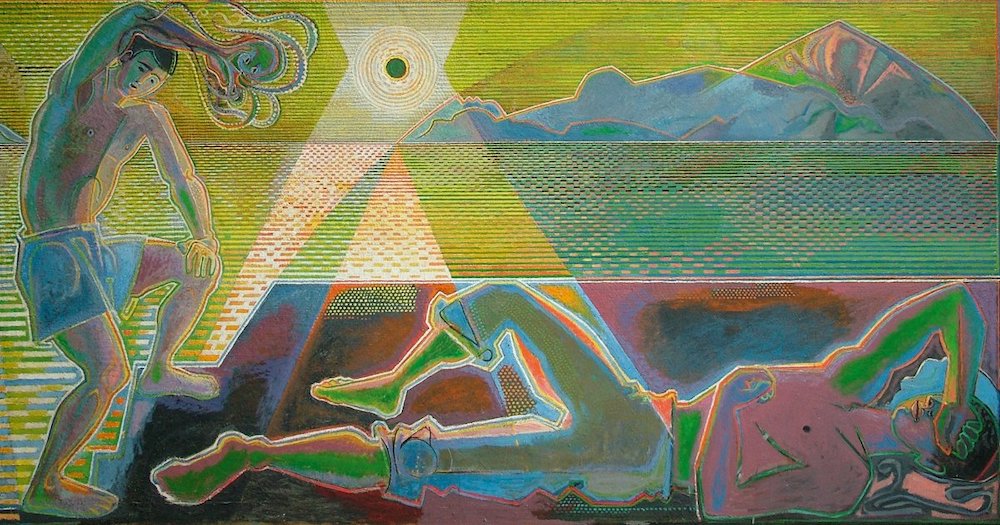
British painter John Craxton, who lived from 1922 until 2009, is known for his iconic depiction of his beloved second home—Greece.
From a young age, Craxton showed an incredible talent for painting, as well as a complex understanding of shape and color. At the age of just 19, Craxton was already considered a prominent figure in the world of modern art in Britain.
John Craxton was inspired by Greece
Working with important figures in art such as Lucian Freud and Graham Sutherland, Craxton developed his skills as a painter. Yet, it was not until the British artist visited Greece that his artistic vision fully blossomed.
Upon arriving in the country in 1946, Craxton fell in love with Greece and the beauty of its landscapes, people, and traditions.
‘Still Life with Three Sailors’, 1980-1985, ‘Sleeping Fisherman’, 1948, and ‘Landscape with the Elements’, 1973 by John Craxton. Craxton first visited Greece in 1946 and made it his home. He absorbed and transformed its traditions both of life and art. pic.twitter.com/WSawMKwDgX
— Nicholas Colloff (@ncolloff) January 8, 2021
“I felt at home at once,” he said. “As my first contact with the Mediterranean and the discovery of the action of light, the way light and shadow behave, the arrival in Greece was astonishing. . . . This new world fitted me artistically, and suited me socially and financially.”
While his previous work was heavy, dark, and solitary, the paintings he produced in Greece were vibrant and full of life. Craxton particularly loved painting portraits but also animals, such as cats and goats, both of which are inextricably linked to Greece.
Painted on the island of Poros, the oil on canvas Hotel by the Sea (1946), an exquisitely composed, sumptuously colored, and boldly drawn sea, field, and hill scape, is very different in mood from his black-and-white work of a few years before, has a perspective and formal distortions showing the increasing influence on him of Byzantine art and Cubism and exploiting the flatness of his canvas.
Some of John Craxton’s gorgeous work in & on #Greece at @britishmuseum #ART. pic.twitter.com/aIdAk2VjZV
— Byzantine Ambassador (@byzantinepower) June 24, 2018
John Craxton makes Crete his home
In 1948 Craxton first visited Crete (where he was to settle 12 years later).
In Greece, he worked on such dramatic paintings as the deceptively simple Tin Olive Oil Can (1955) in its tones of purple, silver and green (now one of several pieces by him in the Government Art Collection) and Still Life with Cat and Child (1959), its formal distortions created by a mix of perspectives, which was bought by the Tate in 1995.
Even after settling in the Cretan town of Chania in 1960, he retained a base in London and showed there from time to time in the 1960s and 1980s, although in general, he exhibited rarely because he famously found it difficult to finish a painting.
Another enjoyable show… John Craxton and Niko Ghika’s works currently in the British Museum’s ‘Charmed Lives in Greece’ (with Patrick Leigh Fermor). The 80s Craxton ‘Still Life with Three Sailors’ looks particularly fantastic on the gallery’s deep maroon wall. pic.twitter.com/EMzgObvrvp
— Jon Lys Turner (@jonlysturner) March 13, 2018
Among the most notable works of his time in Crete is his incredible tapestry entitled “Landscape with the Elements.” Inspired by traditional Cretan weaving, the tapestry embodies Craxton’s appreciation for and love of Greece.
As Christos Paridis writes in Tavernamag he became part of the local society. He had adopted the local customs, the Mediterranean diet, drinking tsikoudia and wine and enjoyed good food and drinking amongst friends. He spent many hours in Kafeneia and Tavernas discussing – in perfect Greek with a dash of Cretan dialect – while eating and drinking, and he always carried a sketchbook with him, used to draw everyday life scenes: dishes, musicians and men dancing. He would become the life of the party, an inexhaustible explosion of fun.
In his interview for the catalogue of his retrospective show in London’s Whitechapel Gallery in 1967 he wrote: “I have lived and travelled in Greece a lot. I have been charmed by the country and its people, thanks to a mutual liking, a natural well-being and the way my personal philosophy seems to have an affinity with the Greek philosophy, more than anything else”.
In 1992 he was appointed Consular Correspondent in Chania, in which capacity he helped to sort out British tourists’ passport difficulties or brushes with the local police. The following year, in London, he was elected a Royal Academician.
Craxton did not marry. He is survived by his long-term companion, Richard Riley.